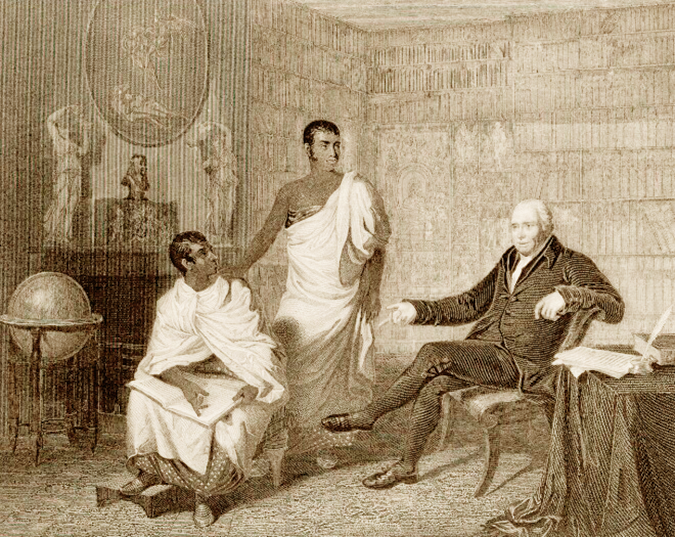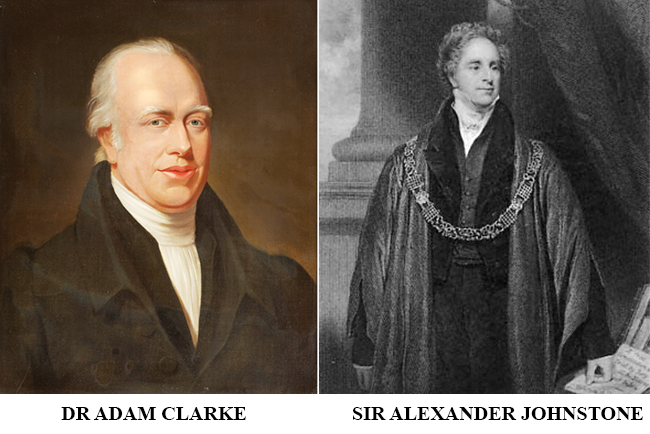FEATURES
THE 19th CENTURY BAPTISM OF TWO BUDDHIST MONKS WHO TRAVELLED TO ENGLAND:

Dr ADAM CLARKE AND THE TWO BUDDHIST PRIESTS
AND THE CULTURAL METAMORPHOSIS OF THEIR DESCENDANTS
by HUGH KARUNANAYAKE
In 1818, Sir Alexander Johnstone the retiring Chief Justice of Ceylon, took with him to England, two Buddhist Priests from Ceylon, and placed them under Rev Adam Clarke DD for their ‘education’.
Sir Alexander Johnstone was the third Chief Justice of Ceylon and was a liberal minded colonial official who endeavoured to understand the culture and indigenous religious practices then prevalent in the island. He assisted in bringing the historic epic The Mahavamsa to European attention, and the reforms he initiated in Ceylon included the right to universal public education, freedom of religious practice, and the employment of local people in government service.
Dr Clarke was a well known theologian and the author of several books on theology and divinity. The two priests were Ven Dharma Rama Therrunanse, and his cousin Ven Siri Guna Muni Ratne Therunnanse, both of the Dodanduwa temple near Galle. The picture shown below is of Rev Adam Clarke and the two priests in their robes, was engraved by H Robinson from an original painting by Alexander Moses, and is presently with the Royal Asiatic Society, London. The engraving forms the frontispiece of the book ” Christian k
Keepsake and Missionary Annual” by Rev W Ellis 1835.
The circumstances under which the two priests went to England are best explained in the words of Rev Ellis who wrote thus: “I have rarely been so interested as by the account Sir Alexander Johnstone gave me of the two young priests, whose enterprise had as many difficulties, and a far higher object, than our forefather’s pilgrimages to the Holy Land. They waited on Sir Alexander, to consult him as to the means of reaching England. Lady Johnstone’s health rendering an instant return imperative, he had set out a small vessel whose accommodation was too limited to admit more than his own family and suite. In this ship however, the priests worked their way as common sailors.
“Before we can appreciate this sacrifice, we must understand that they were of birth, education, of high standing in their own country. Let us for a moment suppose that one of our prelates working before the mast on a mission of Christian faith, we shall then comprehend the depth and sincerity of the belief that urged the young Cingalese. Sir Alexander placed them under the care of Dr Adam Clarke of Liverpool, rightly judging that London with its usual selfish and stimulating course of lionisation, would defeat the high purpose of their visit.
“The progress of the strangers was so satisfactory, that at the end of two years Dr Clarke publicly baptized them. They returned to Ceylon where one was employed as a missionary, and the other as an officer in the civil service. The benefit of their example and instruction may be more easily imagined than calculated.”
Upon their conversion to Christianity, the two priests were baptized at Brunswick Chapel, Liverpool on March 12, 1820.
Siri Muni received the name Adam Sirimuniratne after Dr Adam Clarke his godfather. The other priest was named Alexander Dharmaratne after his sponsors Sir Alexander and Lady Johnstone. The name Alexander is perpetuated by the descendants of Dharmaratne up to the generation of today.
At the Annual Bible society meeting held at Black Wall on May 21, 1820, Field Marshal His Royal Highness the Duke of Gloucester, brother of His Majesty King William IV had the pleasure of according Alexander Dharmaratne( later appointed Mudaliyar) equal seats with his Royal Highness and to touch him on his shoulder. In honour of that gesture the congregation that assembled at the meeting presented him with a figure of a hand with an inscription on it to convey to all and sundry of that wonderful touch of the Royal hand!
The Mudaliyar enjoyed the exclusive privilege of the use of the epithet Rajakumarun ekaputudun affixed to his name. He was thus the first Sinhalese to be honoured by Royalty, many years before Sir Solomon Dias Bandarnaike was vested with a sword and belt with special authority to use the name Rajakumaru kadukeralu. The whirligigs of time however brings on its own revenges and we find Sir Solomon’s son SWRD putting paid to all that by abolishing imperial honours permanently!
Alexander Dharmaratne returned to Ceylon as Private Secretary to Sir Richard Otley, Chief Justice who succeeded Sir Alexander Johnstone. Dharmaratne was later to be Mudaliyar of Galkissa, Moratuwa, and Panadura. The service he rendered to the Government during the 1848 rebellion which was put down with a ferocity not known till then, was appreciated by the British, but looked down as an act of betrayal by his countrymen.
He was invited to Queens House by Viscount Torrington and thanked for his loyalty. His immediate superior Mr Woodhouse, Government Agent, wrote to all Heads of Departments to encourage the family of Mudaliyar Dharmaratne. Some of his children were as a consequence employed in government service.
The Mudaliyar died after 34 years of faithful service to the government, leaving eight sons most of whom were in government service. The most eminent of his sons was George Dharmaratne, Advocate, Barrister at law of the Middle Temple, and a Freemason of the Caveac Lodge of London. He was called to the English Bar on November 17, 1877.Although he was popularly referred to as the first Sinhalese barrister, that honour really belongs to Harry Dias who was admitted and enrolled to the English Bar on May 7, 1847.
George Alexander Dharmaratne was the first proponent of Swaraj or self rule for Ceylon. He addressed the first memorandum to the House of commons seeking independence for Ceylon. He was a great admirer of Napoleon Bonaparte and named two of his sons after the famous generals of Napoleon, Ney and Soult.
Ney Alexander Dharmaratne was educated at Royal College and was a cricketer of no mean repute. His name appears in the bowling records of the book ” Sixty Years of Ceylon Cricket’ by SP Foenander 1924. He took to law and was in the First Law Medical encounter.
He passed out as a Proctor in 1906 and was widely regarded as the most brilliant criminal lawyer that ever practised in the Chilaw Courts. He was reputed for his lavish entertainment. It was however alcohol that undid him. He died on December 31, 1923, buried the following day, and forgotten by most people he helped on the next day. Such is life!
Ney Alexander. Dharmaratne married Hilda Nellie Pereira the daughter of John Walter Pereira and had six chidren Hildan, Clive, Edgar, Thelma, Ansel, and Vernon. Hildan was also educated at Royal College and represented his school in cricket and soccer. Among his team mates were LDS Gunasekera, DWL Lieversz, and JR Jayewardene, former President of Sri Lanka.
Hildan married Violet Berenger in July 1930 and had four children Bryan, Fritz, Cecil and Michael. Bryan too was educated at Royal College and played cricket and rugby for the school. Like his father Hildan, Bryan too kept wickets for Royal College. Bryan migrated to Australia in 1971 followed by Cecil and Michael. Bryan lives in Sydney with wife Jeanne.
Adam Muni Ratne returned to Ceylon and enrolled as a clergyman of the Methodist Church. His son Adam Ratne was educated first at Royal College, and on the increase of school fees at Royal he enrolled at S Thomas College in Mutwal. He too joined the Metodist Church as a clergyman.
The narrative on the adventure of the two monks do reveal genealogical assimilations that could occur over a period of two centuries, and could be considered as part of that all encompassing vehicle known as modernisation.

